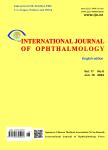Two novel variants in CYP1B1 gene: a major contributor of autosomal recessive primary congenital glaucoma with allelic heterogeneity in Pakistani patients
Two novel variants in CYP1B1 gene: a major contributor of autosomal recessive primary congenital glaucoma with allelic heterogeneity in Pakistani patients作者机构:Molecular Biology and Genetics Department Liaquat University of Medical and Health Sciences Department of Biochemistry Islamia UniversityBahawalpur Institute of Ophthalmology Liaquat University of Medical and Health Sciences Department of Human Genetics University of Health SciencesLahore Center of Excellence in Marine Biology University of Karachi
出 版 物:《International Journal of Ophthalmology(English edition)》 (国际眼科杂志(英文版))
年 卷 期:2019年第12卷第1期
页 面:8-15页
核心收录:
学科分类:10[医学]
基 金:supported by Pakistan Sciences Foundation Grant (No: Biotech-101) LUMHS Intramural Funds to Ali M Waryah
主 题:CYP1B1 mutations primary congenital glaucoma genetics
摘 要:AIM: To find the CYP1 B1 mutations associated with primary congenital glaucoma(PCG) in Pakistani consanguineous pedigrees. METHODS: After getting informed consent, 11 consanguineous pedigrees belonging to different ethnic groups were enrolled. Detailed medical history was recorded and pedigrees were drawn. The standard ophthalmological examination was done to characterize the phenotype. Genomic DNA was extracted from 10 mL whole blood and coding exons and exon intron boundaries of CYP1 B1 gene were directly sequenced. Bioinformatics tools were used to model the mutant protein and predict the effect of novel variants on protein structure and function. RESULTS: Sequencing analysis revealed 5 different CYP1 B1 variants in 7 families(7/11; 64%), including two novel variants. A common mutation, p.R390 H was found in four families, whereas p.P437 L was found once in a family. Two novel variants, a homozygous non sense variant p.L13* and a compound heterozygous variant, p.P350 T along with p.V364 M were segregating with PCGin two families. All the patients had the variable onset and severity of the disease. The success rate of early clinical interventions was observed dependent on mutation types and position. Two different haplotypes were associated with frequently found mutation, p.R390 H. CONCLUSION: Identification of novel CYP1 B1 variants reassert the genetic heterogeneity of Pakistani PCG patients. The patients with missense mutations show severe phenotypic presentations and poor vision after surgical interventions as compare to patients with null variants. This may help to better understand the role of CYP1 B1 mutations in the development of PCG and its course of pathogenicity.



